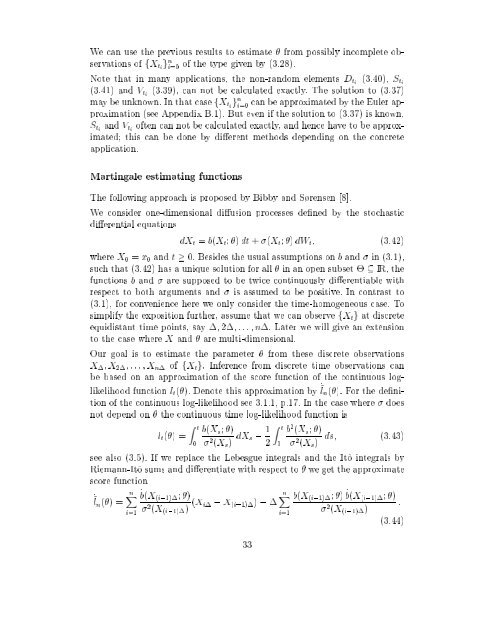Estimation in Financial Models - RiskLab
Estimation in Financial Models - RiskLab
Estimation in Financial Models - RiskLab
You also want an ePaper? Increase the reach of your titles
YUMPU automatically turns print PDFs into web optimized ePapers that Google loves.
We can use the previous results to estimate from possibly <strong>in</strong>complete observations<br />
of fX ti g n i=0<br />
of the type given by (3.28).<br />
Note that <strong>in</strong> many applications, the non-random elements D ti (3.40), S ti<br />
(3.41) and V ti (3.39), can not be calculated exactly. The solution to (3.37)<br />
may be unknown. In that case fX ti g n i=0<br />
can be approximated by the Euler approximation<br />
(see Appendix B.1). But even if the solution to (3.37) is known,<br />
S ti and V ti often can not be calculated exactly, and hence have to be approximated;<br />
this can be done by dierent methods depend<strong>in</strong>g on the concrete<br />
application.<br />
Mart<strong>in</strong>gale estimat<strong>in</strong>g functions<br />
The follow<strong>in</strong>g approach is proposed by Bibby and Srensen [8].<br />
We consider one-dimensional diusion processes dened by the stochastic<br />
dierential equations<br />
dX t = b(X t ; ) dt + (X t ; ) dW t ; (3.42)<br />
where X 0 = x 0 and t 0. Besides the usual assumptions on b and <strong>in</strong> (3.1),<br />
such that (3.42) has a unique solution for all <strong>in</strong> an open subset IR, the<br />
functions b and are supposed to be twice cont<strong>in</strong>uously dierentiable with<br />
respect to both arguments and is assumed to be positive. In contrast to<br />
(3.1), for convenience here we only consider the time-homogeneous case. To<br />
simplify the exposition further, assume that we can observe fX t g at discrete<br />
equidistant time po<strong>in</strong>ts, say ; 2;:::;n. Later we will give an extension<br />
to the case where X and are multi-dimensional.<br />
Our goal is to estimate the parameter from these discrete observations<br />
X ;X 2 ;:::;X n of fX t g. Inference from discrete time observations can<br />
be based on an approximation of the score function of the cont<strong>in</strong>uous loglikelihood<br />
function l t (). Denote this approximation by ~ _ ln (). For the denition<br />
of the cont<strong>in</strong>uous log-likelihood see 3.1.1, p.17. In the case where does<br />
not depend on the cont<strong>in</strong>uous time log-likelihood function is<br />
l t () =<br />
Z t<br />
0<br />
b(X s ; )<br />
2 (X s ) dX s , 1 2<br />
Z t<br />
0<br />
b 2 (X s ; )<br />
2 (X s )<br />
ds; (3.43)<br />
see also (3.5). If we replace the Lebesgue <strong>in</strong>tegrals and the It^o <strong>in</strong>tegrals by<br />
Riemann-It^o sums and dierentiate with respect to we get the approximate<br />
score function<br />
nX _b(X (i,1) ; )<br />
nX<br />
_~l n () =<br />
<br />
i=1<br />
2 (X (i,1) ) (X b(X (i,1) ; ) b(X<br />
i , X (i,1) ) , <br />
_ (i,1) ; )<br />
:<br />
<br />
i=1<br />
2 (X (i,1) )<br />
(3.44)<br />
33
















